An estimated 3.4 billion people in 92 countries are at risk of malaria infection
A surge in malaria transmission following flooding events underlines yet again the link between climate change and its impact on the spread of the disease.
The World Health Organisation (WHO) warns that climate change could lead to approximately a quarter of a million additional deaths per year between 2030 and 2050, attributed to malnutrition, malaria, diarrhoea, and heat stress. The impacts of climate change on malaria transmission are already being felt in most regions.
Malaria, the world’s most important and deadly tropical mosquito-borne parasitic disease, kills approximately 1 million people and afflicts as many as one billion people in 109 countries throughout Africa, Asia, and Latin America.
An estimated 3.4 billion people in 92 countries are at risk of malaria infection.
In a recent article, Lancet says that a better climate knowledge and forecasts will be essential for safeguarding malaria public health outcomes.
The warmer temperatures, the article explains, speed up the growth cycle of the malaria parasite in the Anopheles mosquito, enabling it to develop more quickly for transmission.
Longer summers and warmer winters could also extend the seasons typical for mosquitoes to live and breed. Evidence already exists that increasing temperatures expand the geographical areas that are suitable for mosquitoes, exposing populations to malaria who have low immunity to the disease.
“With the planet now 1•1°C warmer than in 1800 and climate extremes and disasters becoming more frequent, funders and malaria organisations say that the threat of increased malaria transmission is already evident,” the article reads citing a spike in the disease after severe flooding in Pakistan and Mozambique, or the first local transmission of malaria in the USA in 20 years as examples.
It adds that El Niño weather conditions are set to cause a surge in global temperatures and disruptive climate patterns that could allow malaria-carrying mosquitoes to thrive.
“The links between malaria and climate change are becoming increasingly apparent. Rising temperatures, changing rainfall patterns, and extreme weather events change the range and behaviour of the mosquitoes that carry malaria and other diseases”, the article says quoting Michael Adekunle Charles, CEO of the RBM Partnership to End Malaria.
The Global Fund to Fight AIDS, Tuberculosis and Malaria’s latest grant cycle focuses on making health systems resilient not only to the next pathogen, but also to climate change. It highlighted the surge in malaria that occurred after Pakistan had its worst floods on record between June and October, 2022. In the 3-month period between mid-June and September, 2022, 539 500 cases of malaria were reported in the country, compared with fewer than 400 000 cases for the whole of 2021.
The Global Fund provided US$20 million to Pakistan in emergency funding to support its health system in the aftermath of the floods. It also committed nearly $1 million in emergency funding to Mozambique to mitigate the impact of this year’s Cyclone Freddy and floods on malaria programmes in the country.
Also read: Malaria cure: Need a drug regimen that reduces pill load


















Add Comment